Detailed Analysis: Royal Commission Report on Executive Remuneration
VerifiedAdded on 2022/11/28
|13
|2685
|409
Report
AI Summary
This report provides an analysis of the Royal Commission's report on misconduct in the remuneration of executives within the Australian banking, superannuation, and financial services industry. The report examines the terms of reference, limitations of the inquiry, and the core issues of executive remuneration, including the design and implementation of remuneration systems. It highlights the importance of risk management, the proportion of fixed and variable remuneration, the availability of claw-backs, and the role of regulatory bodies like APRA. The report discusses the problems with implementation and the need for effective supervision and disclosure of consequences. The study emphasizes the impact of the Banking Executive Accountability Regime (BEAR) and the need for adjustments in remuneration to reduce misconduct and align executive behavior with community standards and expectations. The report concludes with a call for improved practices in financial institutions to foster good customer outcomes and sound risk management.
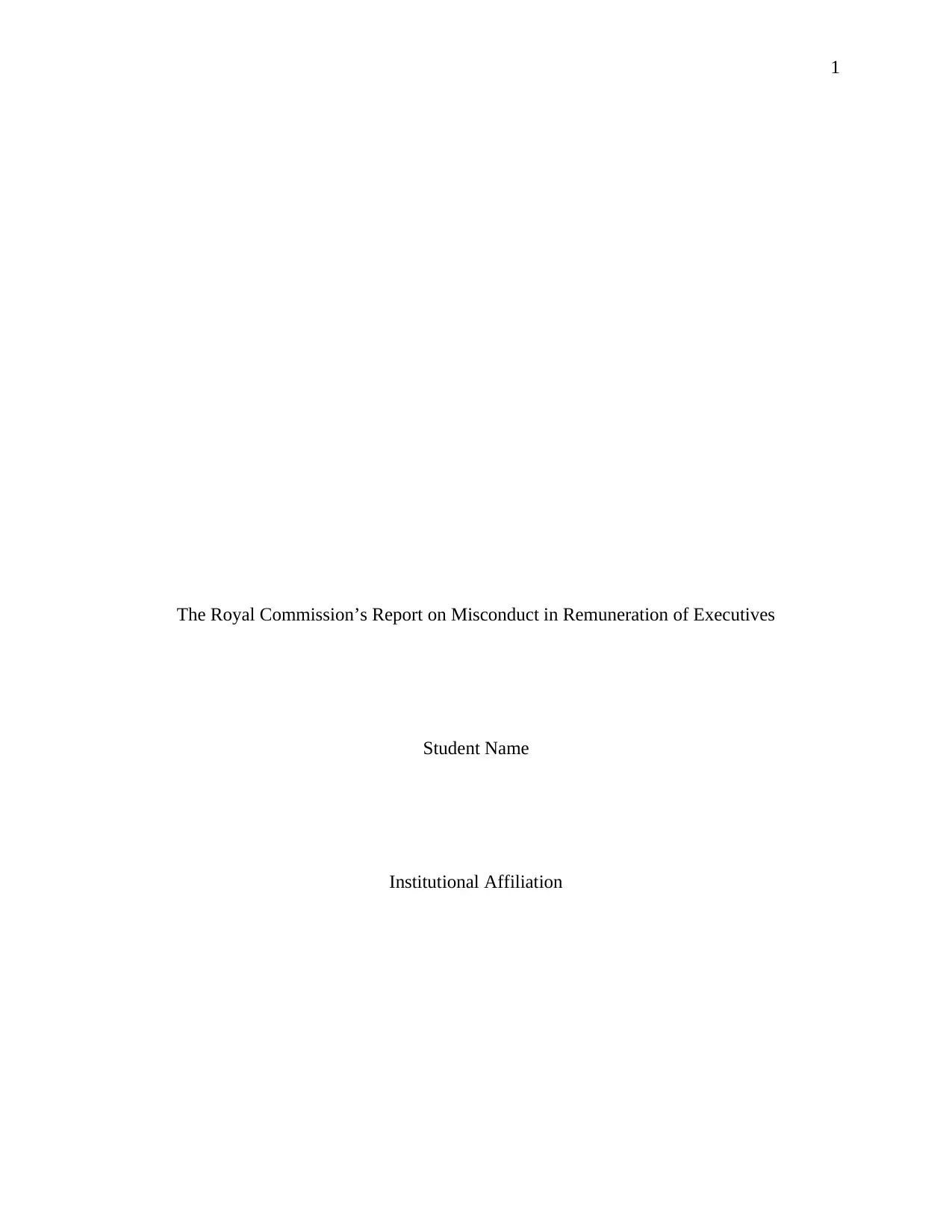
1
The Royal Commission’s Report on Misconduct in Remuneration of Executives
Student Name
Institutional Affiliation
The Royal Commission’s Report on Misconduct in Remuneration of Executives
Student Name
Institutional Affiliation
Paraphrase This Document
Need a fresh take? Get an instant paraphrase of this document with our AI Paraphraser
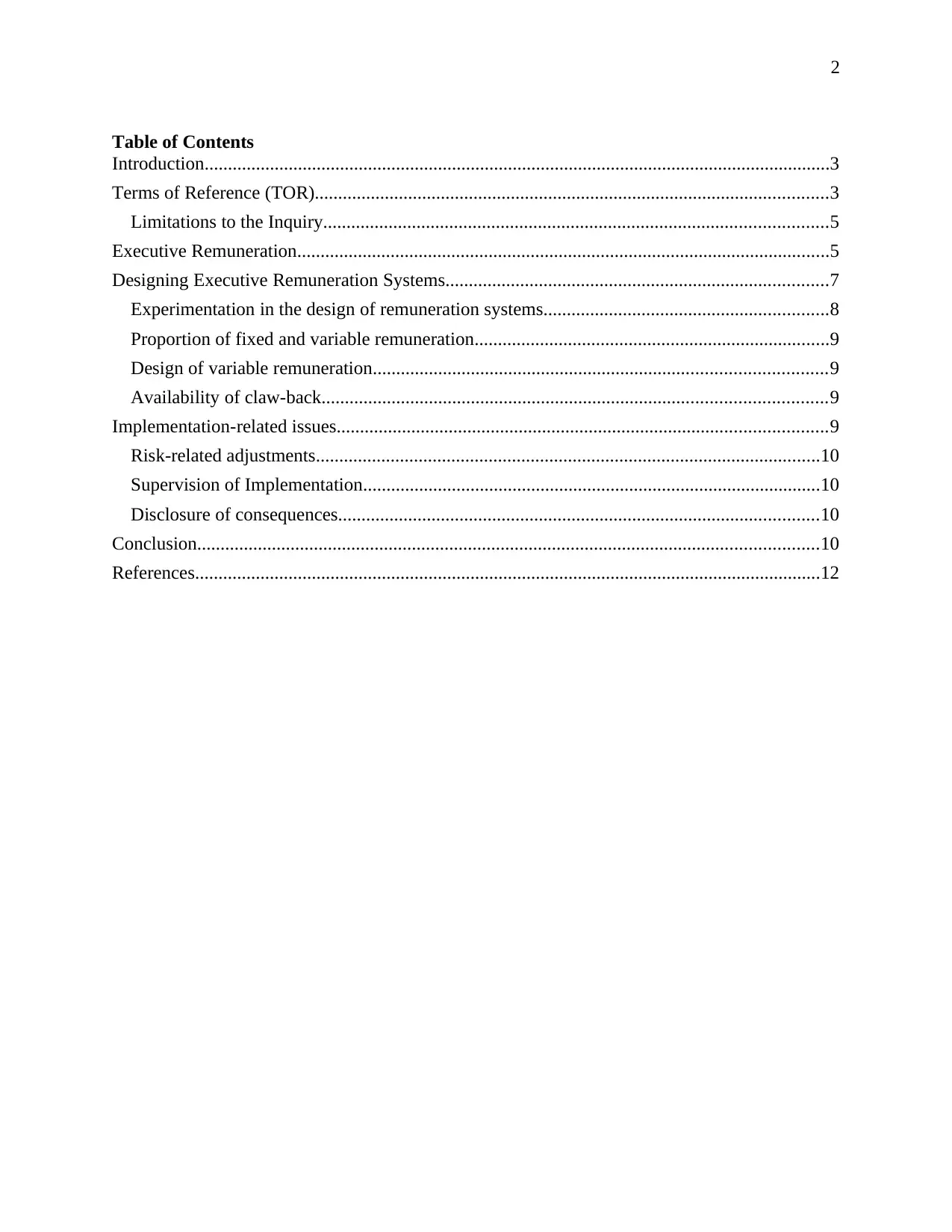
2
Table of Contents
Introduction......................................................................................................................................3
Terms of Reference (TOR)..............................................................................................................3
Limitations to the Inquiry............................................................................................................5
Executive Remuneration..................................................................................................................5
Designing Executive Remuneration Systems..................................................................................7
Experimentation in the design of remuneration systems.............................................................8
Proportion of fixed and variable remuneration............................................................................9
Design of variable remuneration.................................................................................................9
Availability of claw-back............................................................................................................9
Implementation-related issues.........................................................................................................9
Risk-related adjustments............................................................................................................10
Supervision of Implementation..................................................................................................10
Disclosure of consequences.......................................................................................................10
Conclusion.....................................................................................................................................10
References......................................................................................................................................12
Table of Contents
Introduction......................................................................................................................................3
Terms of Reference (TOR)..............................................................................................................3
Limitations to the Inquiry............................................................................................................5
Executive Remuneration..................................................................................................................5
Designing Executive Remuneration Systems..................................................................................7
Experimentation in the design of remuneration systems.............................................................8
Proportion of fixed and variable remuneration............................................................................9
Design of variable remuneration.................................................................................................9
Availability of claw-back............................................................................................................9
Implementation-related issues.........................................................................................................9
Risk-related adjustments............................................................................................................10
Supervision of Implementation..................................................................................................10
Disclosure of consequences.......................................................................................................10
Conclusion.....................................................................................................................................10
References......................................................................................................................................12
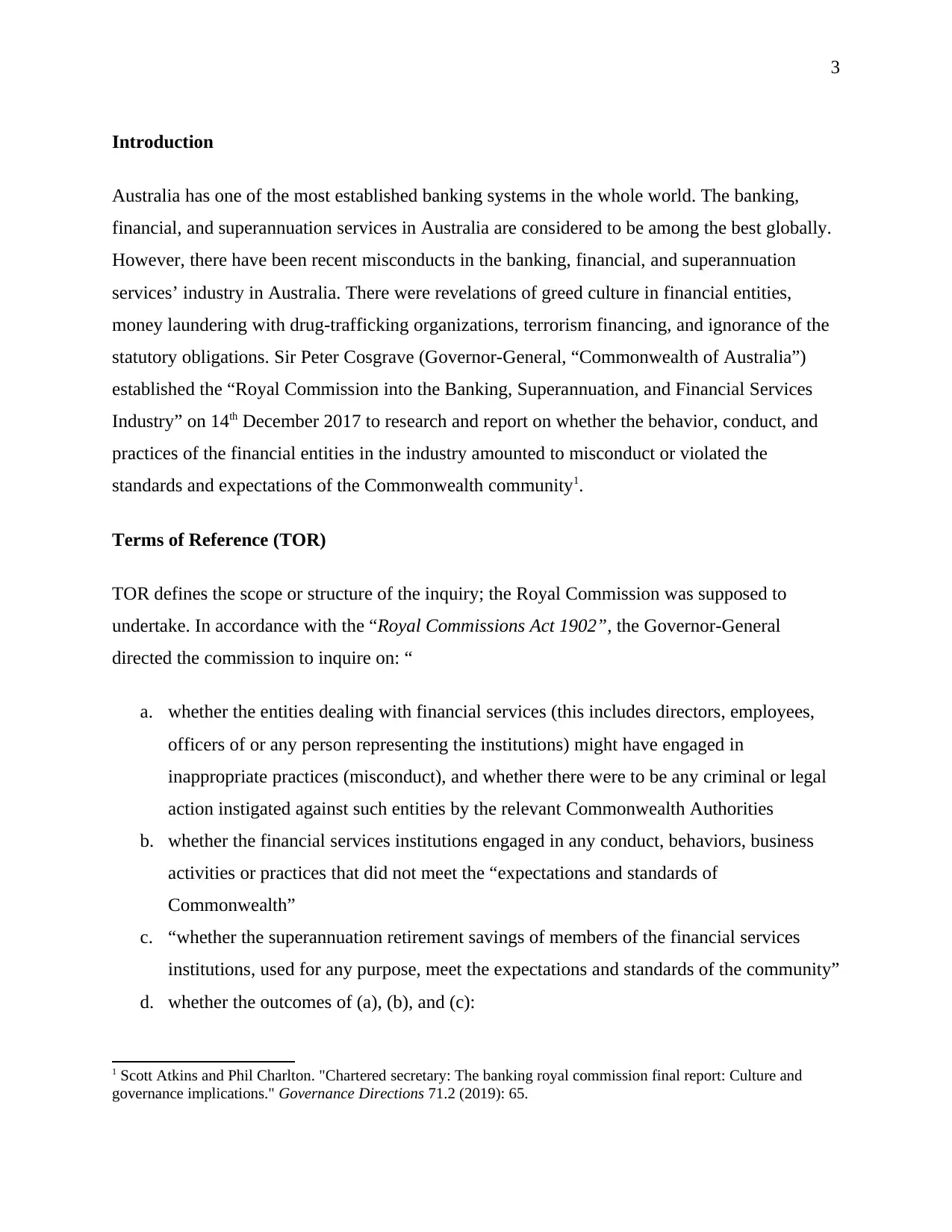
3
Introduction
Australia has one of the most established banking systems in the whole world. The banking,
financial, and superannuation services in Australia are considered to be among the best globally.
However, there have been recent misconducts in the banking, financial, and superannuation
services’ industry in Australia. There were revelations of greed culture in financial entities,
money laundering with drug-trafficking organizations, terrorism financing, and ignorance of the
statutory obligations. Sir Peter Cosgrave (Governor-General, “Commonwealth of Australia”)
established the “Royal Commission into the Banking, Superannuation, and Financial Services
Industry” on 14th December 2017 to research and report on whether the behavior, conduct, and
practices of the financial entities in the industry amounted to misconduct or violated the
standards and expectations of the Commonwealth community1.
Terms of Reference (TOR)
TOR defines the scope or structure of the inquiry; the Royal Commission was supposed to
undertake. In accordance with the “Royal Commissions Act 1902”, the Governor-General
directed the commission to inquire on: “
a. whether the entities dealing with financial services (this includes directors, employees,
officers of or any person representing the institutions) might have engaged in
inappropriate practices (misconduct), and whether there were to be any criminal or legal
action instigated against such entities by the relevant Commonwealth Authorities
b. whether the financial services institutions engaged in any conduct, behaviors, business
activities or practices that did not meet the “expectations and standards of
Commonwealth”
c. “whether the superannuation retirement savings of members of the financial services
institutions, used for any purpose, meet the expectations and standards of the community”
d. whether the outcomes of (a), (b), and (c):
1 Scott Atkins and Phil Charlton. "Chartered secretary: The banking royal commission final report: Culture and
governance implications." Governance Directions 71.2 (2019): 65.
Introduction
Australia has one of the most established banking systems in the whole world. The banking,
financial, and superannuation services in Australia are considered to be among the best globally.
However, there have been recent misconducts in the banking, financial, and superannuation
services’ industry in Australia. There were revelations of greed culture in financial entities,
money laundering with drug-trafficking organizations, terrorism financing, and ignorance of the
statutory obligations. Sir Peter Cosgrave (Governor-General, “Commonwealth of Australia”)
established the “Royal Commission into the Banking, Superannuation, and Financial Services
Industry” on 14th December 2017 to research and report on whether the behavior, conduct, and
practices of the financial entities in the industry amounted to misconduct or violated the
standards and expectations of the Commonwealth community1.
Terms of Reference (TOR)
TOR defines the scope or structure of the inquiry; the Royal Commission was supposed to
undertake. In accordance with the “Royal Commissions Act 1902”, the Governor-General
directed the commission to inquire on: “
a. whether the entities dealing with financial services (this includes directors, employees,
officers of or any person representing the institutions) might have engaged in
inappropriate practices (misconduct), and whether there were to be any criminal or legal
action instigated against such entities by the relevant Commonwealth Authorities
b. whether the financial services institutions engaged in any conduct, behaviors, business
activities or practices that did not meet the “expectations and standards of
Commonwealth”
c. “whether the superannuation retirement savings of members of the financial services
institutions, used for any purpose, meet the expectations and standards of the community”
d. whether the outcomes of (a), (b), and (c):
1 Scott Atkins and Phil Charlton. "Chartered secretary: The banking royal commission final report: Culture and
governance implications." Governance Directions 71.2 (2019): 65.
⊘ This is a preview!⊘
Do you want full access?
Subscribe today to unlock all pages.

Trusted by 1+ million students worldwide
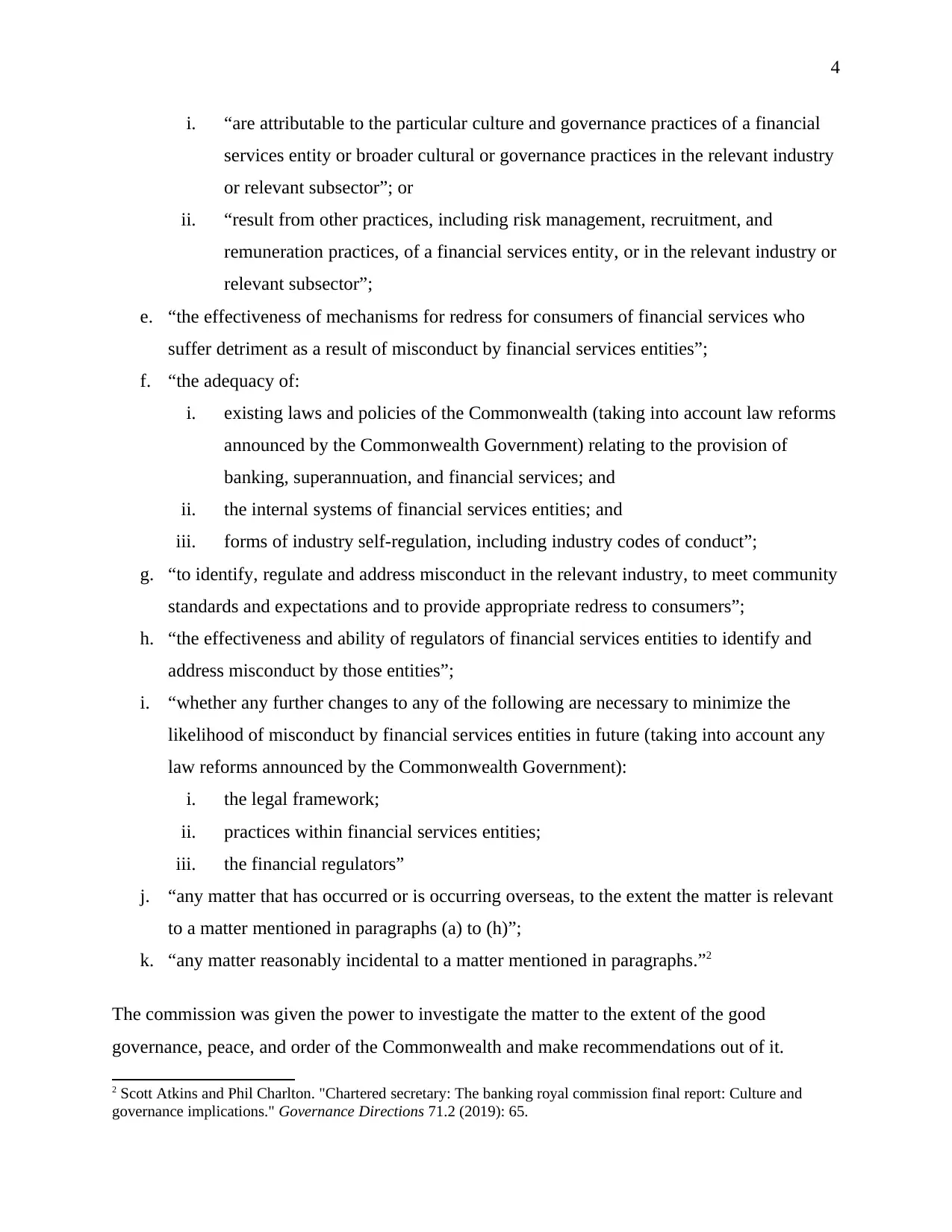
4
i. “are attributable to the particular culture and governance practices of a financial
services entity or broader cultural or governance practices in the relevant industry
or relevant subsector”; or
ii. “result from other practices, including risk management, recruitment, and
remuneration practices, of a financial services entity, or in the relevant industry or
relevant subsector”;
e. “the effectiveness of mechanisms for redress for consumers of financial services who
suffer detriment as a result of misconduct by financial services entities”;
f. “the adequacy of:
i. existing laws and policies of the Commonwealth (taking into account law reforms
announced by the Commonwealth Government) relating to the provision of
banking, superannuation, and financial services; and
ii. the internal systems of financial services entities; and
iii. forms of industry self-regulation, including industry codes of conduct”;
g. “to identify, regulate and address misconduct in the relevant industry, to meet community
standards and expectations and to provide appropriate redress to consumers”;
h. “the effectiveness and ability of regulators of financial services entities to identify and
address misconduct by those entities”;
i. “whether any further changes to any of the following are necessary to minimize the
likelihood of misconduct by financial services entities in future (taking into account any
law reforms announced by the Commonwealth Government):
i. the legal framework;
ii. practices within financial services entities;
iii. the financial regulators”
j. “any matter that has occurred or is occurring overseas, to the extent the matter is relevant
to a matter mentioned in paragraphs (a) to (h)”;
k. “any matter reasonably incidental to a matter mentioned in paragraphs.”2
The commission was given the power to investigate the matter to the extent of the good
governance, peace, and order of the Commonwealth and make recommendations out of it.
2 Scott Atkins and Phil Charlton. "Chartered secretary: The banking royal commission final report: Culture and
governance implications." Governance Directions 71.2 (2019): 65.
i. “are attributable to the particular culture and governance practices of a financial
services entity or broader cultural or governance practices in the relevant industry
or relevant subsector”; or
ii. “result from other practices, including risk management, recruitment, and
remuneration practices, of a financial services entity, or in the relevant industry or
relevant subsector”;
e. “the effectiveness of mechanisms for redress for consumers of financial services who
suffer detriment as a result of misconduct by financial services entities”;
f. “the adequacy of:
i. existing laws and policies of the Commonwealth (taking into account law reforms
announced by the Commonwealth Government) relating to the provision of
banking, superannuation, and financial services; and
ii. the internal systems of financial services entities; and
iii. forms of industry self-regulation, including industry codes of conduct”;
g. “to identify, regulate and address misconduct in the relevant industry, to meet community
standards and expectations and to provide appropriate redress to consumers”;
h. “the effectiveness and ability of regulators of financial services entities to identify and
address misconduct by those entities”;
i. “whether any further changes to any of the following are necessary to minimize the
likelihood of misconduct by financial services entities in future (taking into account any
law reforms announced by the Commonwealth Government):
i. the legal framework;
ii. practices within financial services entities;
iii. the financial regulators”
j. “any matter that has occurred or is occurring overseas, to the extent the matter is relevant
to a matter mentioned in paragraphs (a) to (h)”;
k. “any matter reasonably incidental to a matter mentioned in paragraphs.”2
The commission was given the power to investigate the matter to the extent of the good
governance, peace, and order of the Commonwealth and make recommendations out of it.
2 Scott Atkins and Phil Charlton. "Chartered secretary: The banking royal commission final report: Culture and
governance implications." Governance Directions 71.2 (2019): 65.
Paraphrase This Document
Need a fresh take? Get an instant paraphrase of this document with our AI Paraphraser
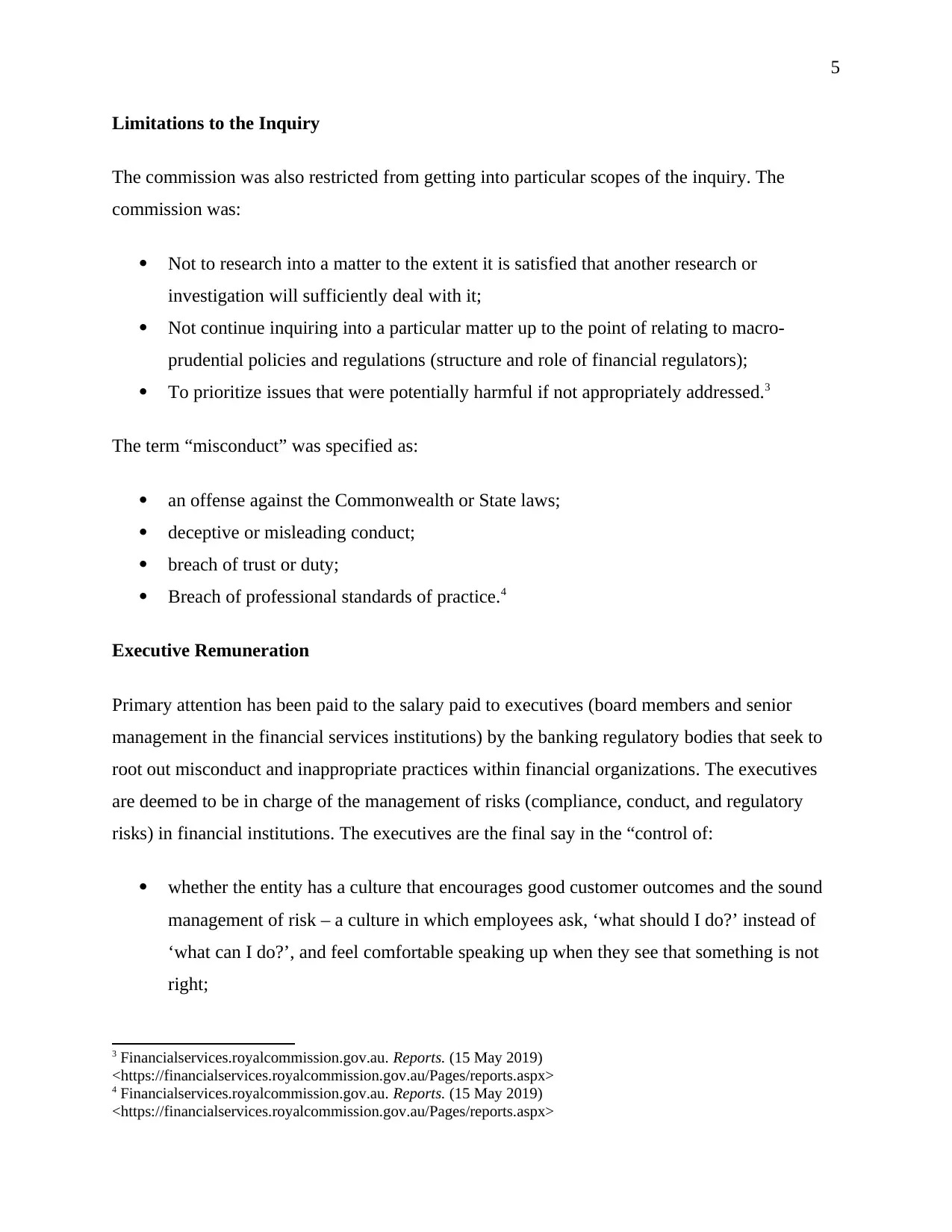
5
Limitations to the Inquiry
The commission was also restricted from getting into particular scopes of the inquiry. The
commission was:
Not to research into a matter to the extent it is satisfied that another research or
investigation will sufficiently deal with it;
Not continue inquiring into a particular matter up to the point of relating to macro-
prudential policies and regulations (structure and role of financial regulators);
To prioritize issues that were potentially harmful if not appropriately addressed.3
The term “misconduct” was specified as:
an offense against the Commonwealth or State laws;
deceptive or misleading conduct;
breach of trust or duty;
Breach of professional standards of practice.4
Executive Remuneration
Primary attention has been paid to the salary paid to executives (board members and senior
management in the financial services institutions) by the banking regulatory bodies that seek to
root out misconduct and inappropriate practices within financial organizations. The executives
are deemed to be in charge of the management of risks (compliance, conduct, and regulatory
risks) in financial institutions. The executives are the final say in the “control of:
whether the entity has a culture that encourages good customer outcomes and the sound
management of risk – a culture in which employees ask, ‘what should I do?’ instead of
‘what can I do?’, and feel comfortable speaking up when they see that something is not
right;
3 Financialservices.royalcommission.gov.au. Reports. (15 May 2019)
<https://financialservices.royalcommission.gov.au/Pages/reports.aspx>
4 Financialservices.royalcommission.gov.au. Reports. (15 May 2019)
<https://financialservices.royalcommission.gov.au/Pages/reports.aspx>
Limitations to the Inquiry
The commission was also restricted from getting into particular scopes of the inquiry. The
commission was:
Not to research into a matter to the extent it is satisfied that another research or
investigation will sufficiently deal with it;
Not continue inquiring into a particular matter up to the point of relating to macro-
prudential policies and regulations (structure and role of financial regulators);
To prioritize issues that were potentially harmful if not appropriately addressed.3
The term “misconduct” was specified as:
an offense against the Commonwealth or State laws;
deceptive or misleading conduct;
breach of trust or duty;
Breach of professional standards of practice.4
Executive Remuneration
Primary attention has been paid to the salary paid to executives (board members and senior
management in the financial services institutions) by the banking regulatory bodies that seek to
root out misconduct and inappropriate practices within financial organizations. The executives
are deemed to be in charge of the management of risks (compliance, conduct, and regulatory
risks) in financial institutions. The executives are the final say in the “control of:
whether the entity has a culture that encourages good customer outcomes and the sound
management of risk – a culture in which employees ask, ‘what should I do?’ instead of
‘what can I do?’, and feel comfortable speaking up when they see that something is not
right;
3 Financialservices.royalcommission.gov.au. Reports. (15 May 2019)
<https://financialservices.royalcommission.gov.au/Pages/reports.aspx>
4 Financialservices.royalcommission.gov.au. Reports. (15 May 2019)
<https://financialservices.royalcommission.gov.au/Pages/reports.aspx>
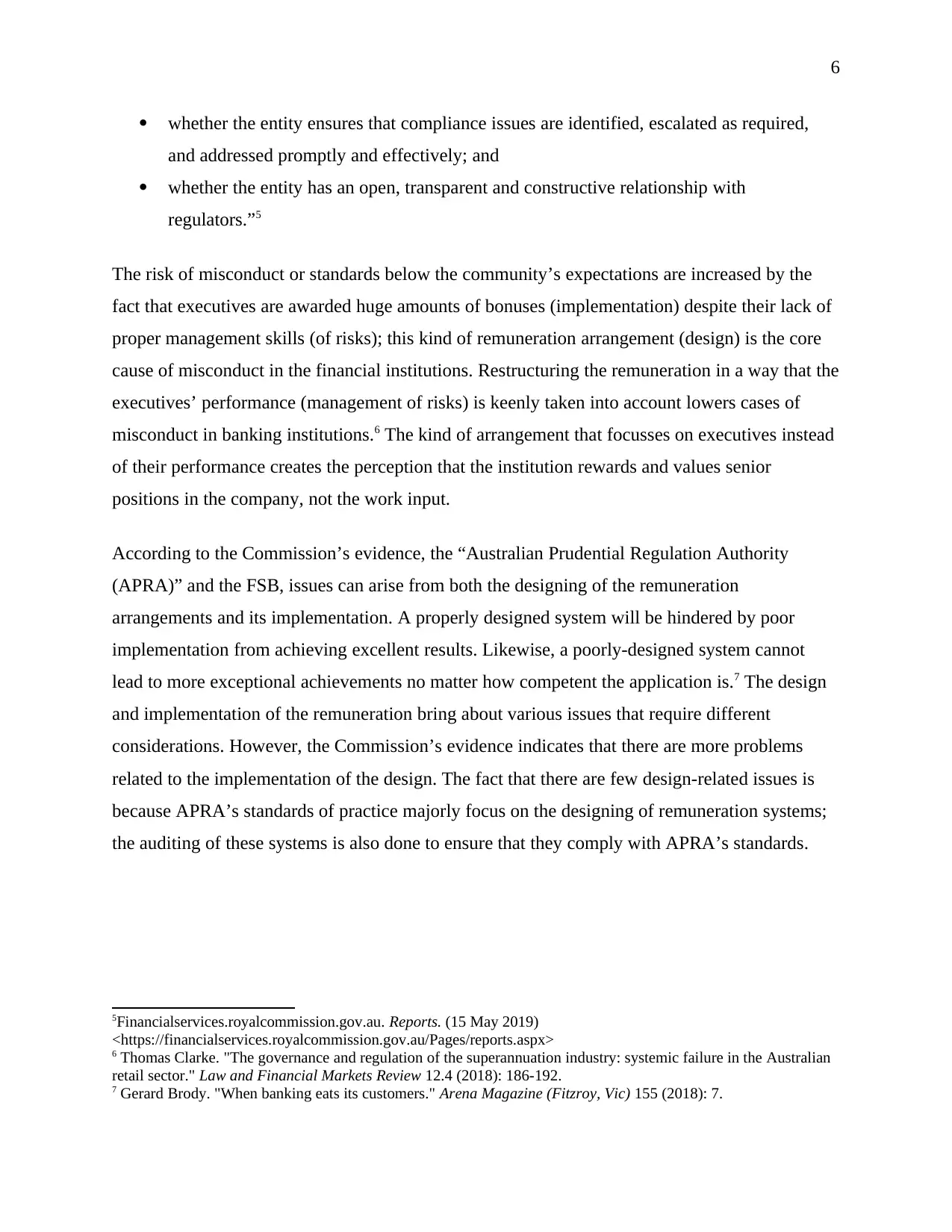
6
whether the entity ensures that compliance issues are identified, escalated as required,
and addressed promptly and effectively; and
whether the entity has an open, transparent and constructive relationship with
regulators.”5
The risk of misconduct or standards below the community’s expectations are increased by the
fact that executives are awarded huge amounts of bonuses (implementation) despite their lack of
proper management skills (of risks); this kind of remuneration arrangement (design) is the core
cause of misconduct in the financial institutions. Restructuring the remuneration in a way that the
executives’ performance (management of risks) is keenly taken into account lowers cases of
misconduct in banking institutions.6 The kind of arrangement that focusses on executives instead
of their performance creates the perception that the institution rewards and values senior
positions in the company, not the work input.
According to the Commission’s evidence, the “Australian Prudential Regulation Authority
(APRA)” and the FSB, issues can arise from both the designing of the remuneration
arrangements and its implementation. A properly designed system will be hindered by poor
implementation from achieving excellent results. Likewise, a poorly-designed system cannot
lead to more exceptional achievements no matter how competent the application is.7 The design
and implementation of the remuneration bring about various issues that require different
considerations. However, the Commission’s evidence indicates that there are more problems
related to the implementation of the design. The fact that there are few design-related issues is
because APRA’s standards of practice majorly focus on the designing of remuneration systems;
the auditing of these systems is also done to ensure that they comply with APRA’s standards.
5Financialservices.royalcommission.gov.au. Reports. (15 May 2019)
<https://financialservices.royalcommission.gov.au/Pages/reports.aspx>
6 Thomas Clarke. "The governance and regulation of the superannuation industry: systemic failure in the Australian
retail sector." Law and Financial Markets Review 12.4 (2018): 186-192.
7 Gerard Brody. "When banking eats its customers." Arena Magazine (Fitzroy, Vic) 155 (2018): 7.
whether the entity ensures that compliance issues are identified, escalated as required,
and addressed promptly and effectively; and
whether the entity has an open, transparent and constructive relationship with
regulators.”5
The risk of misconduct or standards below the community’s expectations are increased by the
fact that executives are awarded huge amounts of bonuses (implementation) despite their lack of
proper management skills (of risks); this kind of remuneration arrangement (design) is the core
cause of misconduct in the financial institutions. Restructuring the remuneration in a way that the
executives’ performance (management of risks) is keenly taken into account lowers cases of
misconduct in banking institutions.6 The kind of arrangement that focusses on executives instead
of their performance creates the perception that the institution rewards and values senior
positions in the company, not the work input.
According to the Commission’s evidence, the “Australian Prudential Regulation Authority
(APRA)” and the FSB, issues can arise from both the designing of the remuneration
arrangements and its implementation. A properly designed system will be hindered by poor
implementation from achieving excellent results. Likewise, a poorly-designed system cannot
lead to more exceptional achievements no matter how competent the application is.7 The design
and implementation of the remuneration bring about various issues that require different
considerations. However, the Commission’s evidence indicates that there are more problems
related to the implementation of the design. The fact that there are few design-related issues is
because APRA’s standards of practice majorly focus on the designing of remuneration systems;
the auditing of these systems is also done to ensure that they comply with APRA’s standards.
5Financialservices.royalcommission.gov.au. Reports. (15 May 2019)
<https://financialservices.royalcommission.gov.au/Pages/reports.aspx>
6 Thomas Clarke. "The governance and regulation of the superannuation industry: systemic failure in the Australian
retail sector." Law and Financial Markets Review 12.4 (2018): 186-192.
7 Gerard Brody. "When banking eats its customers." Arena Magazine (Fitzroy, Vic) 155 (2018): 7.
⊘ This is a preview!⊘
Do you want full access?
Subscribe today to unlock all pages.

Trusted by 1+ million students worldwide
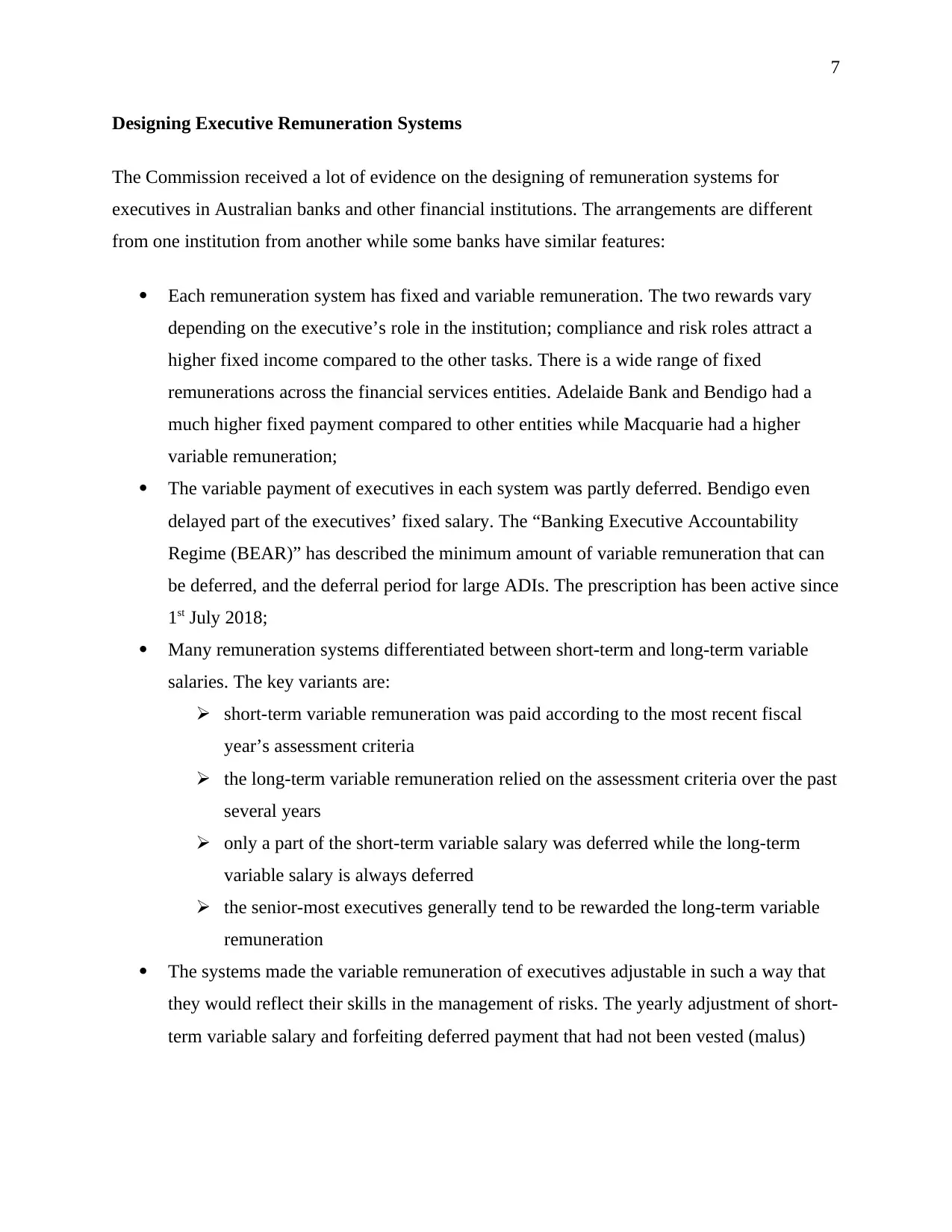
7
Designing Executive Remuneration Systems
The Commission received a lot of evidence on the designing of remuneration systems for
executives in Australian banks and other financial institutions. The arrangements are different
from one institution from another while some banks have similar features:
Each remuneration system has fixed and variable remuneration. The two rewards vary
depending on the executive’s role in the institution; compliance and risk roles attract a
higher fixed income compared to the other tasks. There is a wide range of fixed
remunerations across the financial services entities. Adelaide Bank and Bendigo had a
much higher fixed payment compared to other entities while Macquarie had a higher
variable remuneration;
The variable payment of executives in each system was partly deferred. Bendigo even
delayed part of the executives’ fixed salary. The “Banking Executive Accountability
Regime (BEAR)” has described the minimum amount of variable remuneration that can
be deferred, and the deferral period for large ADIs. The prescription has been active since
1st July 2018;
Many remuneration systems differentiated between short-term and long-term variable
salaries. The key variants are:
short-term variable remuneration was paid according to the most recent fiscal
year’s assessment criteria
the long-term variable remuneration relied on the assessment criteria over the past
several years
only a part of the short-term variable salary was deferred while the long-term
variable salary is always deferred
the senior-most executives generally tend to be rewarded the long-term variable
remuneration
The systems made the variable remuneration of executives adjustable in such a way that
they would reflect their skills in the management of risks. The yearly adjustment of short-
term variable salary and forfeiting deferred payment that had not been vested (malus)
Designing Executive Remuneration Systems
The Commission received a lot of evidence on the designing of remuneration systems for
executives in Australian banks and other financial institutions. The arrangements are different
from one institution from another while some banks have similar features:
Each remuneration system has fixed and variable remuneration. The two rewards vary
depending on the executive’s role in the institution; compliance and risk roles attract a
higher fixed income compared to the other tasks. There is a wide range of fixed
remunerations across the financial services entities. Adelaide Bank and Bendigo had a
much higher fixed payment compared to other entities while Macquarie had a higher
variable remuneration;
The variable payment of executives in each system was partly deferred. Bendigo even
delayed part of the executives’ fixed salary. The “Banking Executive Accountability
Regime (BEAR)” has described the minimum amount of variable remuneration that can
be deferred, and the deferral period for large ADIs. The prescription has been active since
1st July 2018;
Many remuneration systems differentiated between short-term and long-term variable
salaries. The key variants are:
short-term variable remuneration was paid according to the most recent fiscal
year’s assessment criteria
the long-term variable remuneration relied on the assessment criteria over the past
several years
only a part of the short-term variable salary was deferred while the long-term
variable salary is always deferred
the senior-most executives generally tend to be rewarded the long-term variable
remuneration
The systems made the variable remuneration of executives adjustable in such a way that
they would reflect their skills in the management of risks. The yearly adjustment of short-
term variable salary and forfeiting deferred payment that had not been vested (malus)
Paraphrase This Document
Need a fresh take? Get an instant paraphrase of this document with our AI Paraphraser
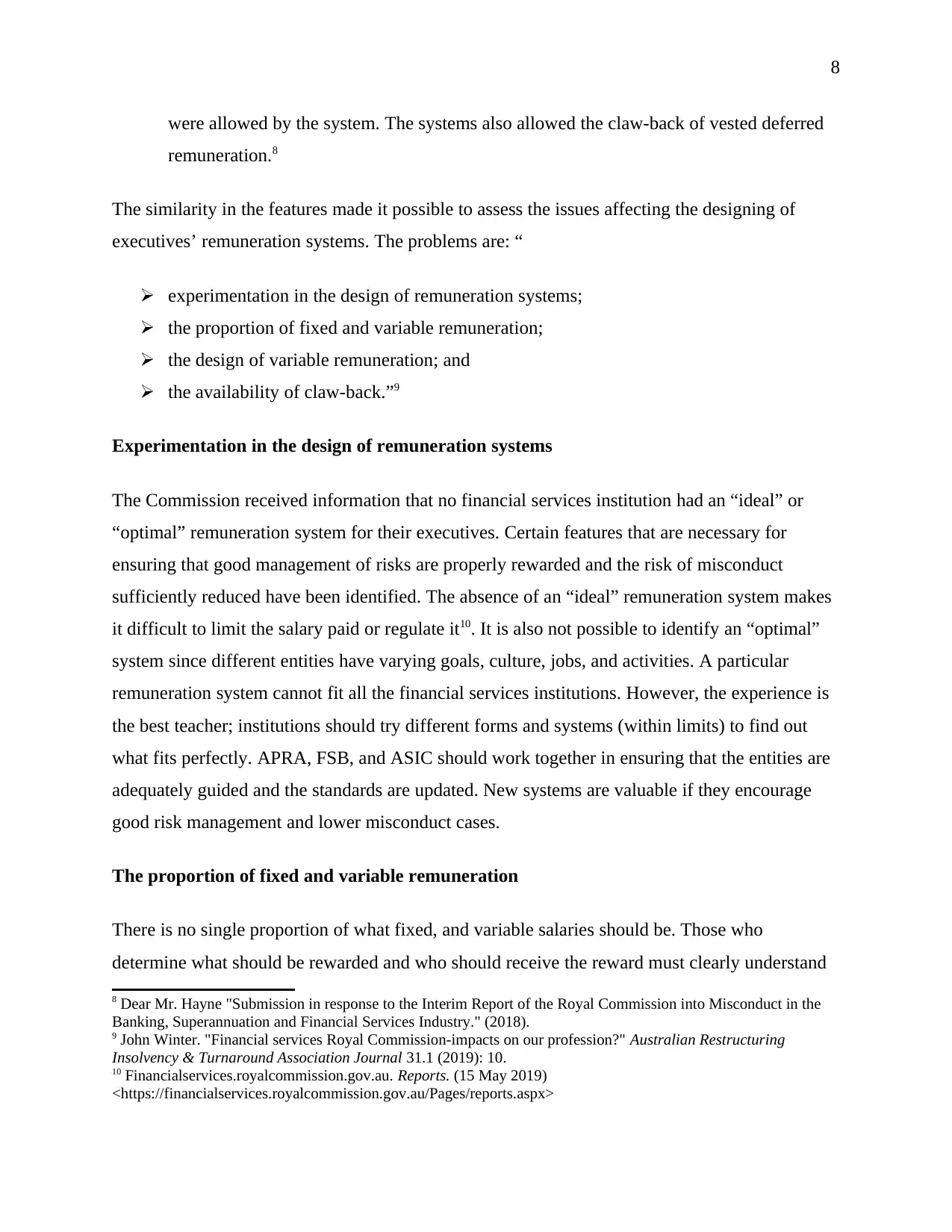
8
were allowed by the system. The systems also allowed the claw-back of vested deferred
remuneration.8
The similarity in the features made it possible to assess the issues affecting the designing of
executives’ remuneration systems. The problems are: “
experimentation in the design of remuneration systems;
the proportion of fixed and variable remuneration;
the design of variable remuneration; and
the availability of claw-back.”9
Experimentation in the design of remuneration systems
The Commission received information that no financial services institution had an “ideal” or
“optimal” remuneration system for their executives. Certain features that are necessary for
ensuring that good management of risks are properly rewarded and the risk of misconduct
sufficiently reduced have been identified. The absence of an “ideal” remuneration system makes
it difficult to limit the salary paid or regulate it10. It is also not possible to identify an “optimal”
system since different entities have varying goals, culture, jobs, and activities. A particular
remuneration system cannot fit all the financial services institutions. However, the experience is
the best teacher; institutions should try different forms and systems (within limits) to find out
what fits perfectly. APRA, FSB, and ASIC should work together in ensuring that the entities are
adequately guided and the standards are updated. New systems are valuable if they encourage
good risk management and lower misconduct cases.
The proportion of fixed and variable remuneration
There is no single proportion of what fixed, and variable salaries should be. Those who
determine what should be rewarded and who should receive the reward must clearly understand
8 Dear Mr. Hayne "Submission in response to the Interim Report of the Royal Commission into Misconduct in the
Banking, Superannuation and Financial Services Industry." (2018).
9 John Winter. "Financial services Royal Commission-impacts on our profession?" Australian Restructuring
Insolvency & Turnaround Association Journal 31.1 (2019): 10.
10 Financialservices.royalcommission.gov.au. Reports. (15 May 2019)
<https://financialservices.royalcommission.gov.au/Pages/reports.aspx>
were allowed by the system. The systems also allowed the claw-back of vested deferred
remuneration.8
The similarity in the features made it possible to assess the issues affecting the designing of
executives’ remuneration systems. The problems are: “
experimentation in the design of remuneration systems;
the proportion of fixed and variable remuneration;
the design of variable remuneration; and
the availability of claw-back.”9
Experimentation in the design of remuneration systems
The Commission received information that no financial services institution had an “ideal” or
“optimal” remuneration system for their executives. Certain features that are necessary for
ensuring that good management of risks are properly rewarded and the risk of misconduct
sufficiently reduced have been identified. The absence of an “ideal” remuneration system makes
it difficult to limit the salary paid or regulate it10. It is also not possible to identify an “optimal”
system since different entities have varying goals, culture, jobs, and activities. A particular
remuneration system cannot fit all the financial services institutions. However, the experience is
the best teacher; institutions should try different forms and systems (within limits) to find out
what fits perfectly. APRA, FSB, and ASIC should work together in ensuring that the entities are
adequately guided and the standards are updated. New systems are valuable if they encourage
good risk management and lower misconduct cases.
The proportion of fixed and variable remuneration
There is no single proportion of what fixed, and variable salaries should be. Those who
determine what should be rewarded and who should receive the reward must clearly understand
8 Dear Mr. Hayne "Submission in response to the Interim Report of the Royal Commission into Misconduct in the
Banking, Superannuation and Financial Services Industry." (2018).
9 John Winter. "Financial services Royal Commission-impacts on our profession?" Australian Restructuring
Insolvency & Turnaround Association Journal 31.1 (2019): 10.
10 Financialservices.royalcommission.gov.au. Reports. (15 May 2019)
<https://financialservices.royalcommission.gov.au/Pages/reports.aspx>
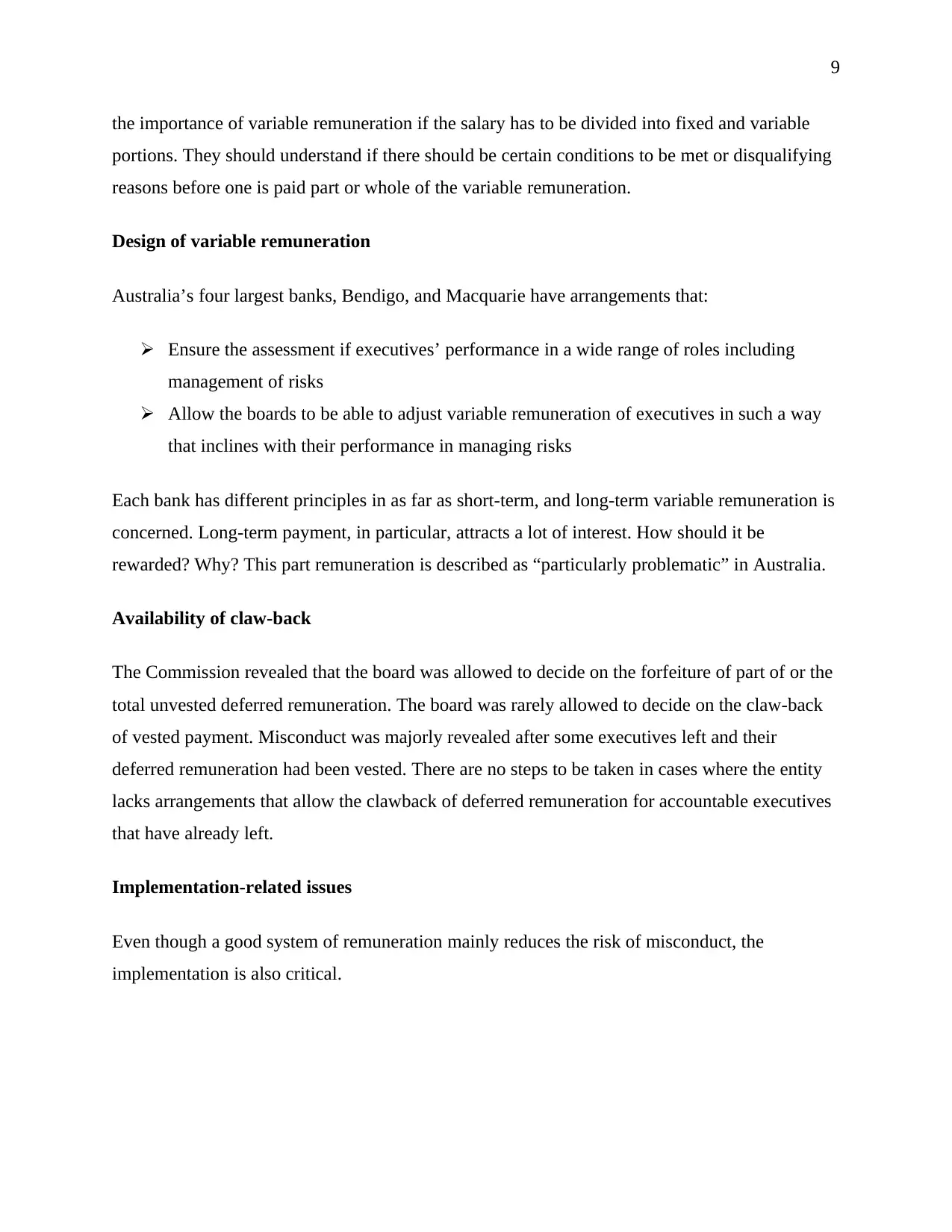
9
the importance of variable remuneration if the salary has to be divided into fixed and variable
portions. They should understand if there should be certain conditions to be met or disqualifying
reasons before one is paid part or whole of the variable remuneration.
Design of variable remuneration
Australia’s four largest banks, Bendigo, and Macquarie have arrangements that:
Ensure the assessment if executives’ performance in a wide range of roles including
management of risks
Allow the boards to be able to adjust variable remuneration of executives in such a way
that inclines with their performance in managing risks
Each bank has different principles in as far as short-term, and long-term variable remuneration is
concerned. Long-term payment, in particular, attracts a lot of interest. How should it be
rewarded? Why? This part remuneration is described as “particularly problematic” in Australia.
Availability of claw-back
The Commission revealed that the board was allowed to decide on the forfeiture of part of or the
total unvested deferred remuneration. The board was rarely allowed to decide on the claw-back
of vested payment. Misconduct was majorly revealed after some executives left and their
deferred remuneration had been vested. There are no steps to be taken in cases where the entity
lacks arrangements that allow the clawback of deferred remuneration for accountable executives
that have already left.
Implementation-related issues
Even though a good system of remuneration mainly reduces the risk of misconduct, the
implementation is also critical.
the importance of variable remuneration if the salary has to be divided into fixed and variable
portions. They should understand if there should be certain conditions to be met or disqualifying
reasons before one is paid part or whole of the variable remuneration.
Design of variable remuneration
Australia’s four largest banks, Bendigo, and Macquarie have arrangements that:
Ensure the assessment if executives’ performance in a wide range of roles including
management of risks
Allow the boards to be able to adjust variable remuneration of executives in such a way
that inclines with their performance in managing risks
Each bank has different principles in as far as short-term, and long-term variable remuneration is
concerned. Long-term payment, in particular, attracts a lot of interest. How should it be
rewarded? Why? This part remuneration is described as “particularly problematic” in Australia.
Availability of claw-back
The Commission revealed that the board was allowed to decide on the forfeiture of part of or the
total unvested deferred remuneration. The board was rarely allowed to decide on the claw-back
of vested payment. Misconduct was majorly revealed after some executives left and their
deferred remuneration had been vested. There are no steps to be taken in cases where the entity
lacks arrangements that allow the clawback of deferred remuneration for accountable executives
that have already left.
Implementation-related issues
Even though a good system of remuneration mainly reduces the risk of misconduct, the
implementation is also critical.
⊘ This is a preview!⊘
Do you want full access?
Subscribe today to unlock all pages.

Trusted by 1+ million students worldwide
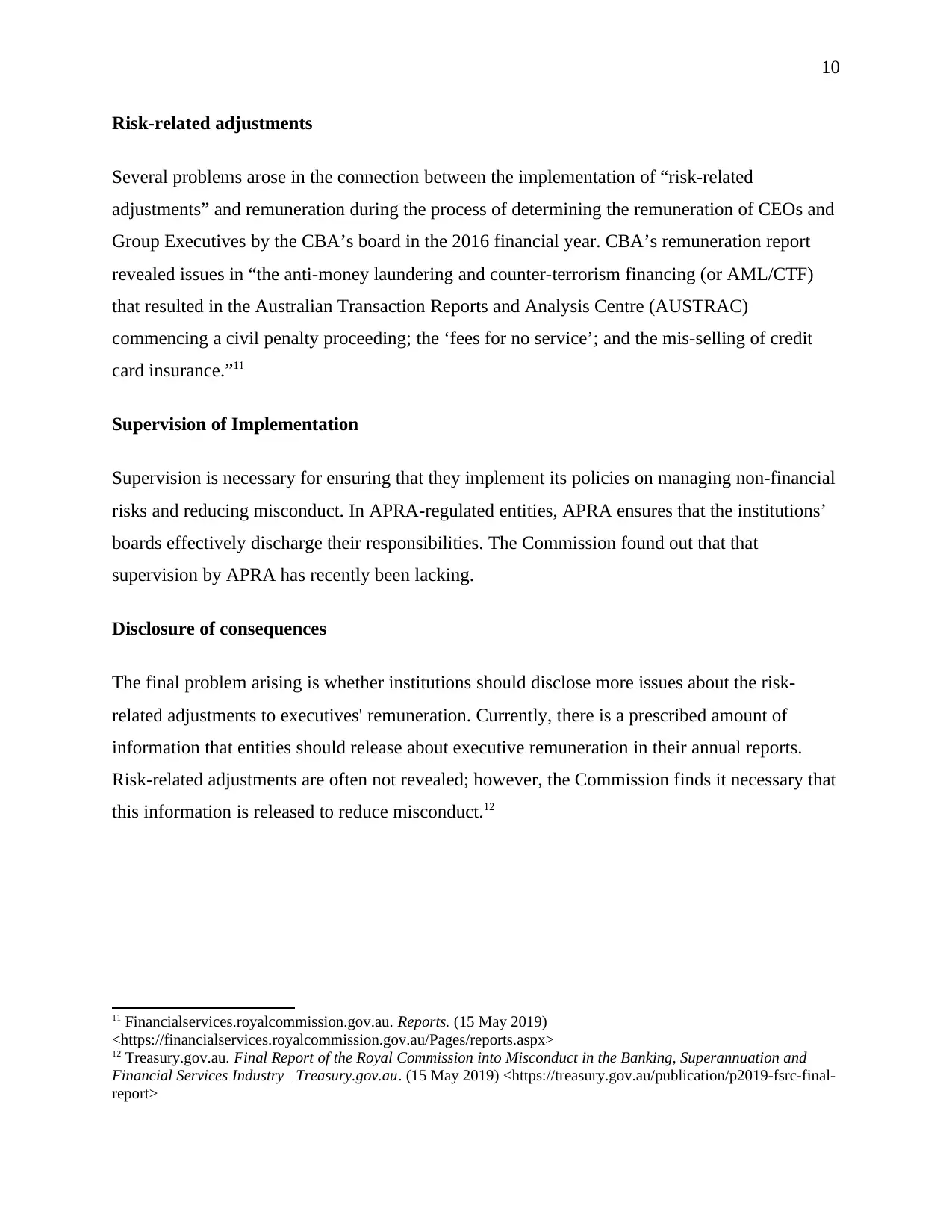
10
Risk-related adjustments
Several problems arose in the connection between the implementation of “risk-related
adjustments” and remuneration during the process of determining the remuneration of CEOs and
Group Executives by the CBA’s board in the 2016 financial year. CBA’s remuneration report
revealed issues in “the anti-money laundering and counter-terrorism financing (or AML/CTF)
that resulted in the Australian Transaction Reports and Analysis Centre (AUSTRAC)
commencing a civil penalty proceeding; the ‘fees for no service’; and the mis-selling of credit
card insurance.”11
Supervision of Implementation
Supervision is necessary for ensuring that they implement its policies on managing non-financial
risks and reducing misconduct. In APRA-regulated entities, APRA ensures that the institutions’
boards effectively discharge their responsibilities. The Commission found out that that
supervision by APRA has recently been lacking.
Disclosure of consequences
The final problem arising is whether institutions should disclose more issues about the risk-
related adjustments to executives' remuneration. Currently, there is a prescribed amount of
information that entities should release about executive remuneration in their annual reports.
Risk-related adjustments are often not revealed; however, the Commission finds it necessary that
this information is released to reduce misconduct.12
11 Financialservices.royalcommission.gov.au. Reports. (15 May 2019)
<https://financialservices.royalcommission.gov.au/Pages/reports.aspx>
12 Treasury.gov.au. Final Report of the Royal Commission into Misconduct in the Banking, Superannuation and
Financial Services Industry | Treasury.gov.au. (15 May 2019) <https://treasury.gov.au/publication/p2019-fsrc-final-
report>
Risk-related adjustments
Several problems arose in the connection between the implementation of “risk-related
adjustments” and remuneration during the process of determining the remuneration of CEOs and
Group Executives by the CBA’s board in the 2016 financial year. CBA’s remuneration report
revealed issues in “the anti-money laundering and counter-terrorism financing (or AML/CTF)
that resulted in the Australian Transaction Reports and Analysis Centre (AUSTRAC)
commencing a civil penalty proceeding; the ‘fees for no service’; and the mis-selling of credit
card insurance.”11
Supervision of Implementation
Supervision is necessary for ensuring that they implement its policies on managing non-financial
risks and reducing misconduct. In APRA-regulated entities, APRA ensures that the institutions’
boards effectively discharge their responsibilities. The Commission found out that that
supervision by APRA has recently been lacking.
Disclosure of consequences
The final problem arising is whether institutions should disclose more issues about the risk-
related adjustments to executives' remuneration. Currently, there is a prescribed amount of
information that entities should release about executive remuneration in their annual reports.
Risk-related adjustments are often not revealed; however, the Commission finds it necessary that
this information is released to reduce misconduct.12
11 Financialservices.royalcommission.gov.au. Reports. (15 May 2019)
<https://financialservices.royalcommission.gov.au/Pages/reports.aspx>
12 Treasury.gov.au. Final Report of the Royal Commission into Misconduct in the Banking, Superannuation and
Financial Services Industry | Treasury.gov.au. (15 May 2019) <https://treasury.gov.au/publication/p2019-fsrc-final-
report>
Paraphrase This Document
Need a fresh take? Get an instant paraphrase of this document with our AI Paraphraser
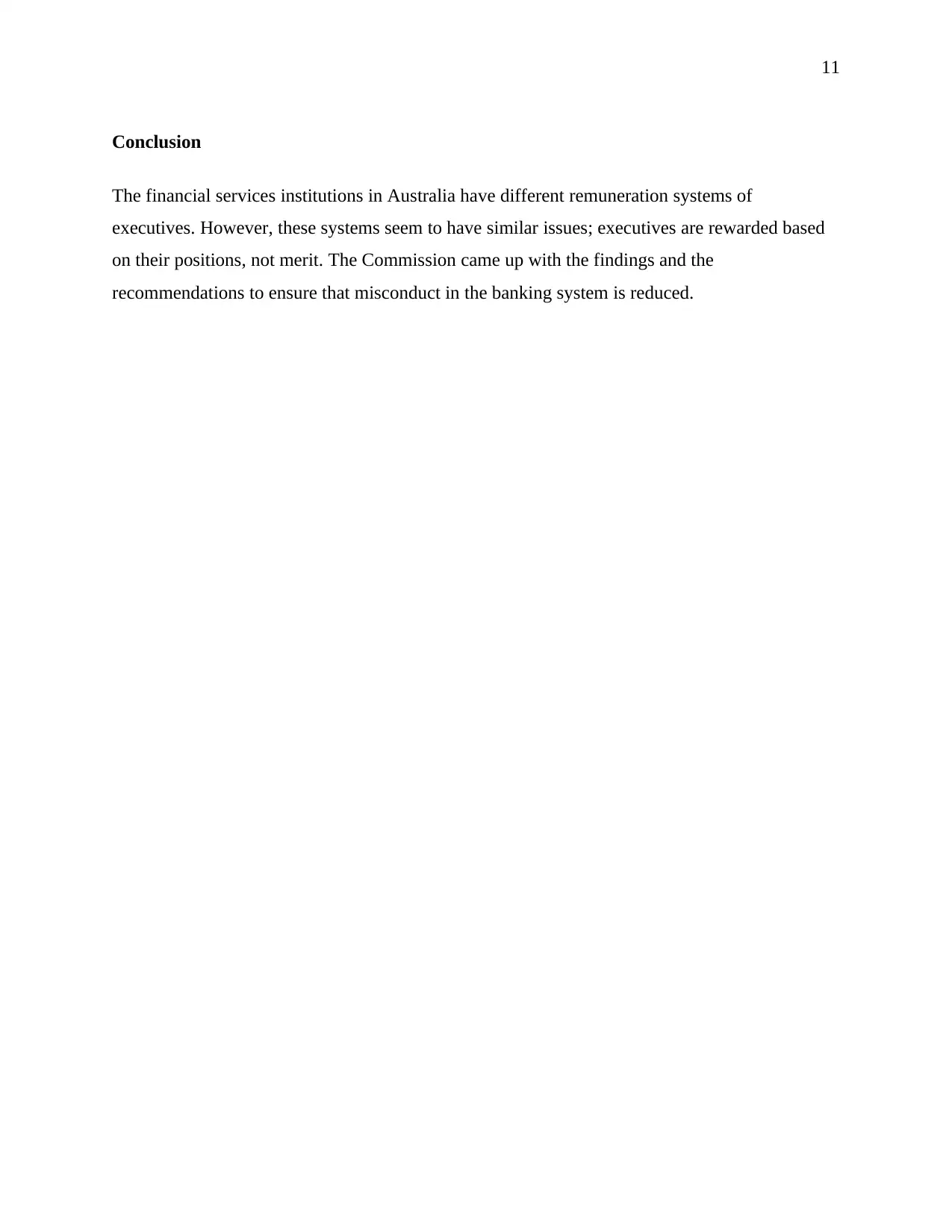
11
Conclusion
The financial services institutions in Australia have different remuneration systems of
executives. However, these systems seem to have similar issues; executives are rewarded based
on their positions, not merit. The Commission came up with the findings and the
recommendations to ensure that misconduct in the banking system is reduced.
Conclusion
The financial services institutions in Australia have different remuneration systems of
executives. However, these systems seem to have similar issues; executives are rewarded based
on their positions, not merit. The Commission came up with the findings and the
recommendations to ensure that misconduct in the banking system is reduced.
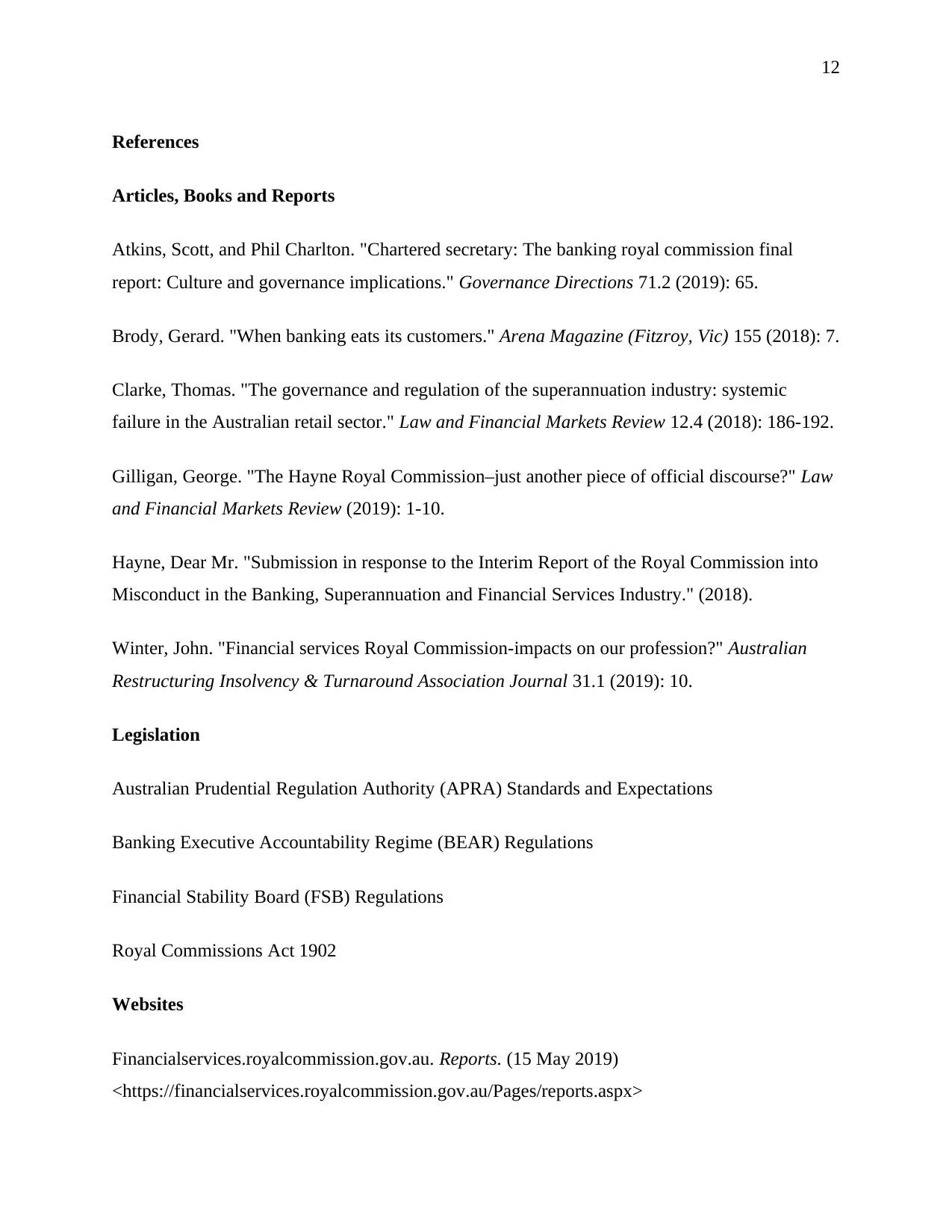
12
References
Articles, Books and Reports
Atkins, Scott, and Phil Charlton. "Chartered secretary: The banking royal commission final
report: Culture and governance implications." Governance Directions 71.2 (2019): 65.
Brody, Gerard. "When banking eats its customers." Arena Magazine (Fitzroy, Vic) 155 (2018): 7.
Clarke, Thomas. "The governance and regulation of the superannuation industry: systemic
failure in the Australian retail sector." Law and Financial Markets Review 12.4 (2018): 186-192.
Gilligan, George. "The Hayne Royal Commission–just another piece of official discourse?" Law
and Financial Markets Review (2019): 1-10.
Hayne, Dear Mr. "Submission in response to the Interim Report of the Royal Commission into
Misconduct in the Banking, Superannuation and Financial Services Industry." (2018).
Winter, John. "Financial services Royal Commission-impacts on our profession?" Australian
Restructuring Insolvency & Turnaround Association Journal 31.1 (2019): 10.
Legislation
Australian Prudential Regulation Authority (APRA) Standards and Expectations
Banking Executive Accountability Regime (BEAR) Regulations
Financial Stability Board (FSB) Regulations
Royal Commissions Act 1902
Websites
Financialservices.royalcommission.gov.au. Reports. (15 May 2019)
<https://financialservices.royalcommission.gov.au/Pages/reports.aspx>
References
Articles, Books and Reports
Atkins, Scott, and Phil Charlton. "Chartered secretary: The banking royal commission final
report: Culture and governance implications." Governance Directions 71.2 (2019): 65.
Brody, Gerard. "When banking eats its customers." Arena Magazine (Fitzroy, Vic) 155 (2018): 7.
Clarke, Thomas. "The governance and regulation of the superannuation industry: systemic
failure in the Australian retail sector." Law and Financial Markets Review 12.4 (2018): 186-192.
Gilligan, George. "The Hayne Royal Commission–just another piece of official discourse?" Law
and Financial Markets Review (2019): 1-10.
Hayne, Dear Mr. "Submission in response to the Interim Report of the Royal Commission into
Misconduct in the Banking, Superannuation and Financial Services Industry." (2018).
Winter, John. "Financial services Royal Commission-impacts on our profession?" Australian
Restructuring Insolvency & Turnaround Association Journal 31.1 (2019): 10.
Legislation
Australian Prudential Regulation Authority (APRA) Standards and Expectations
Banking Executive Accountability Regime (BEAR) Regulations
Financial Stability Board (FSB) Regulations
Royal Commissions Act 1902
Websites
Financialservices.royalcommission.gov.au. Reports. (15 May 2019)
<https://financialservices.royalcommission.gov.au/Pages/reports.aspx>
⊘ This is a preview!⊘
Do you want full access?
Subscribe today to unlock all pages.

Trusted by 1+ million students worldwide
1 out of 13
Related Documents
Your All-in-One AI-Powered Toolkit for Academic Success.
+13062052269
info@desklib.com
Available 24*7 on WhatsApp / Email
![[object Object]](/_next/static/media/star-bottom.7253800d.svg)
Unlock your academic potential
Copyright © 2020–2025 A2Z Services. All Rights Reserved. Developed and managed by ZUCOL.





